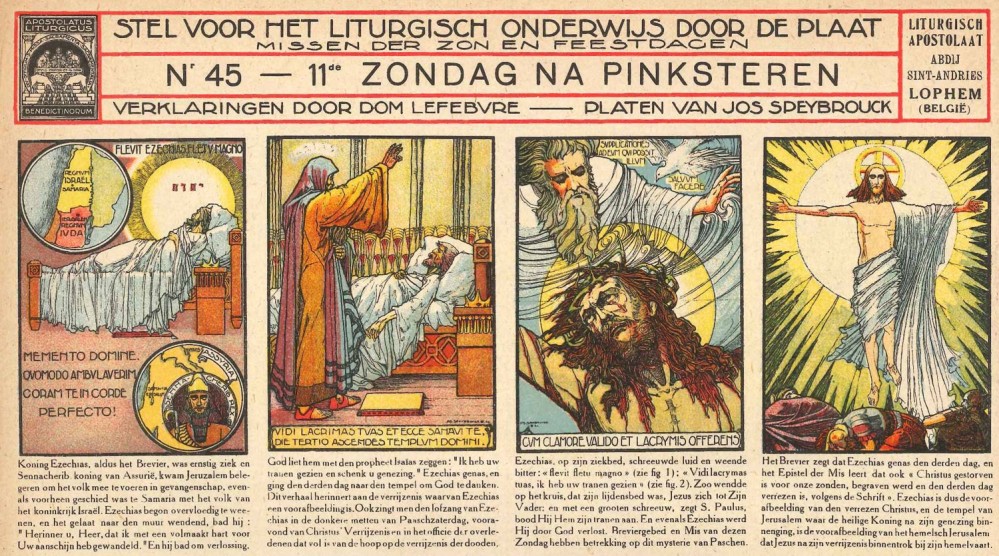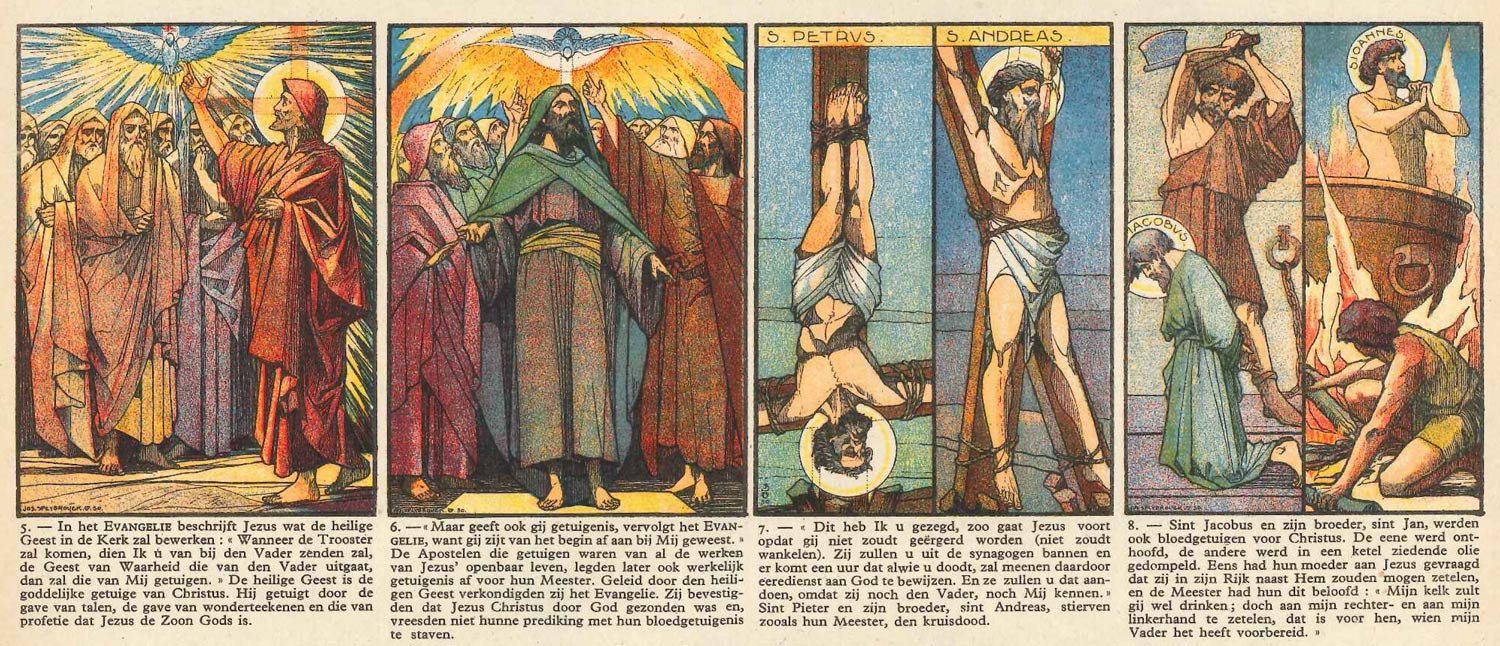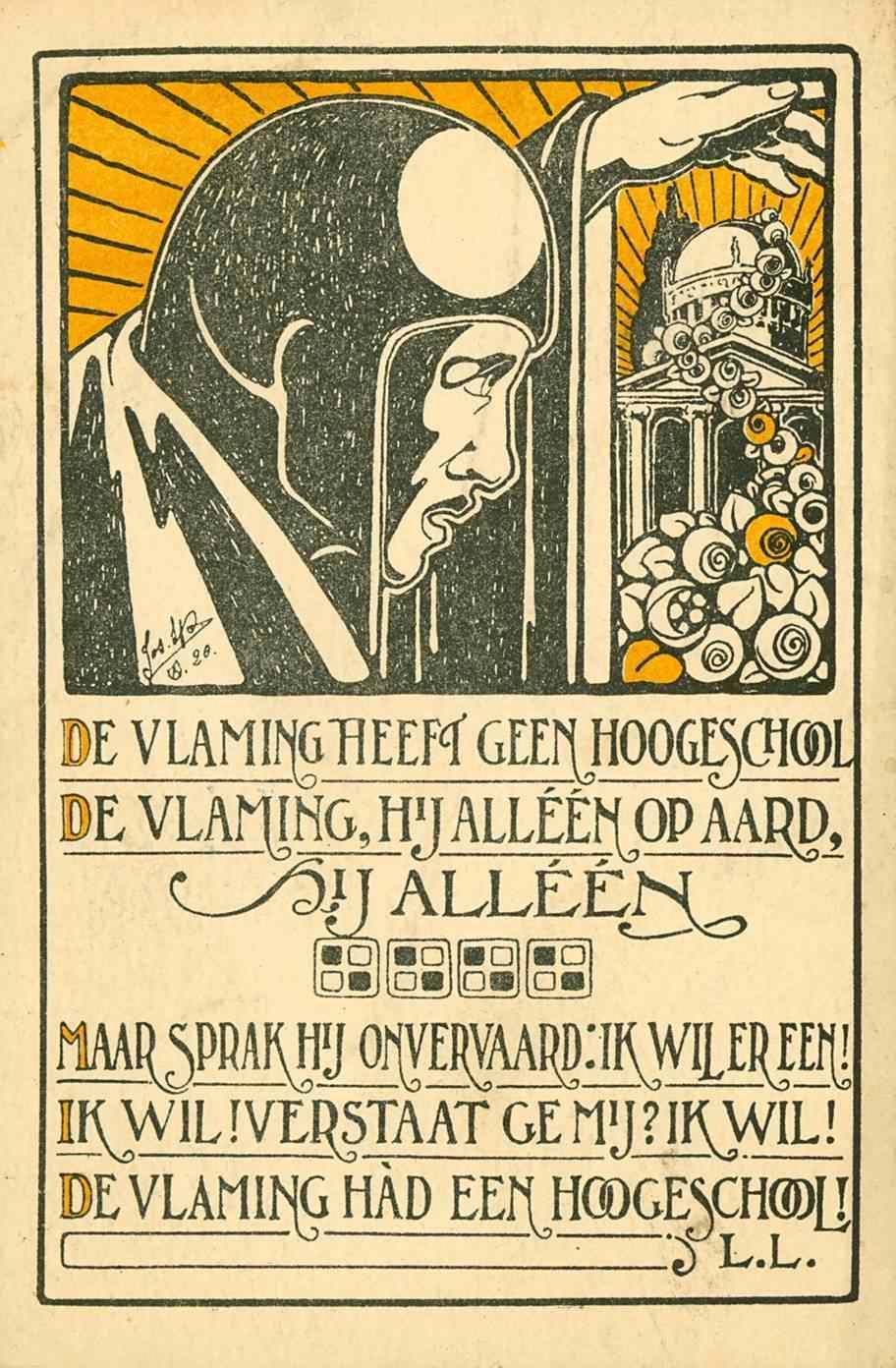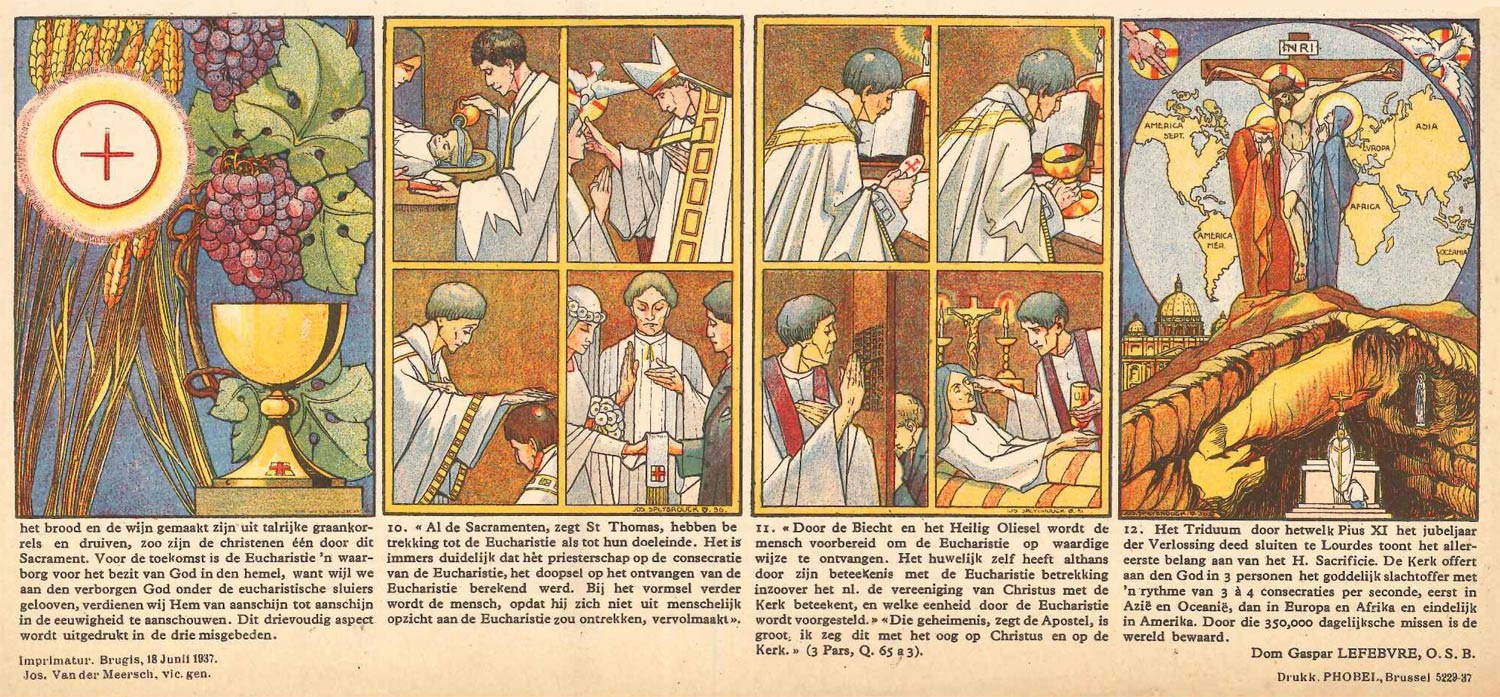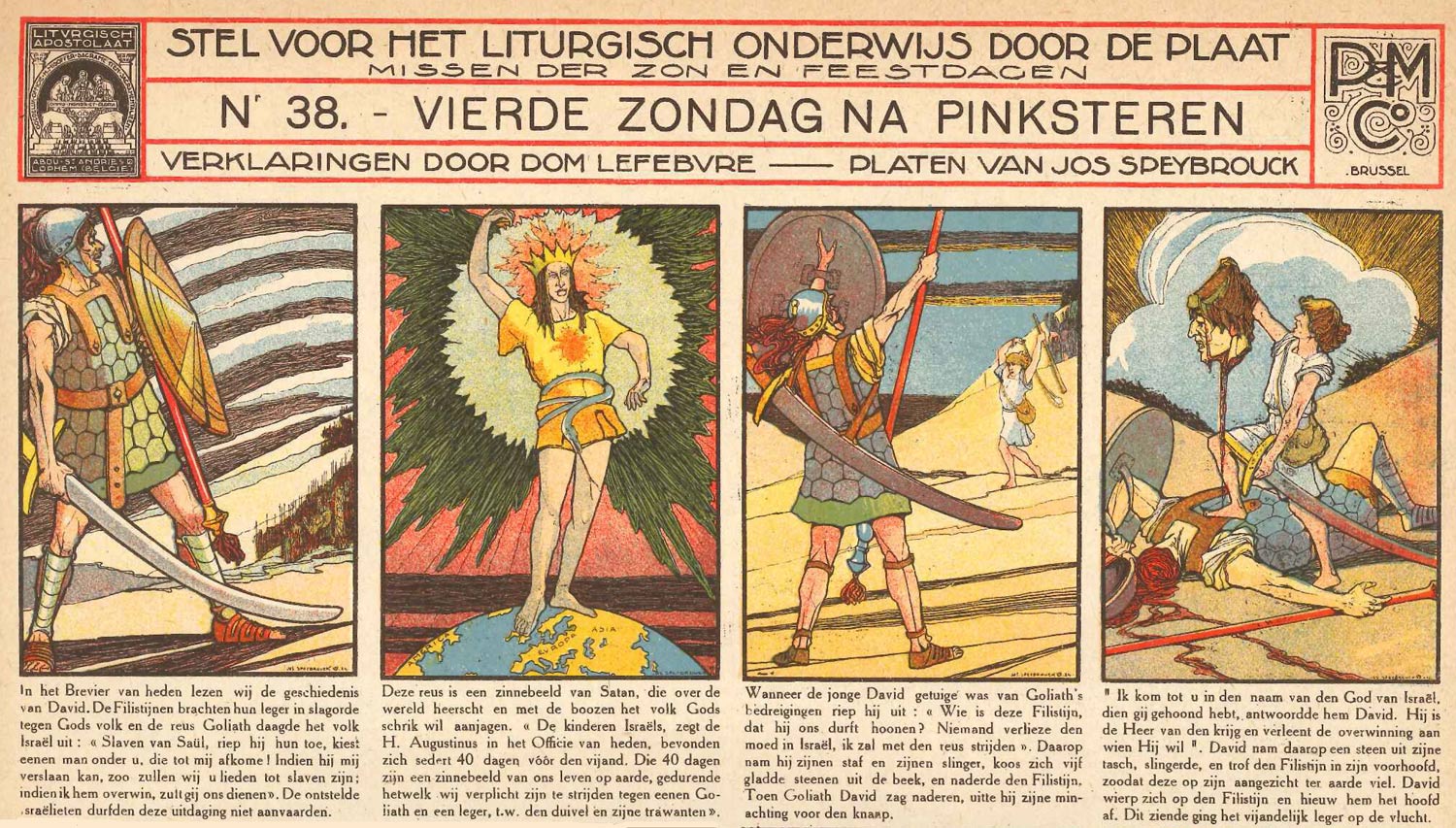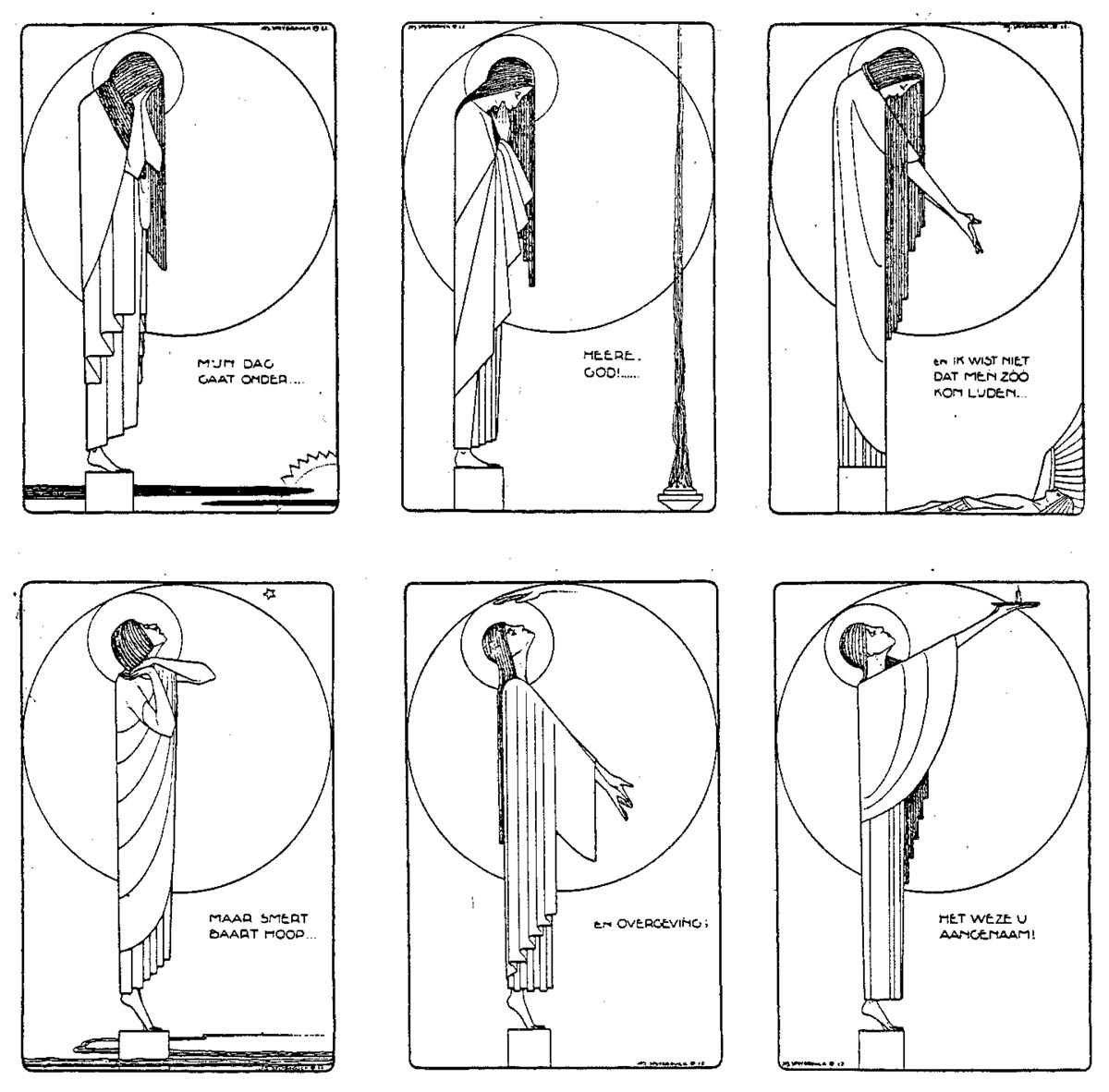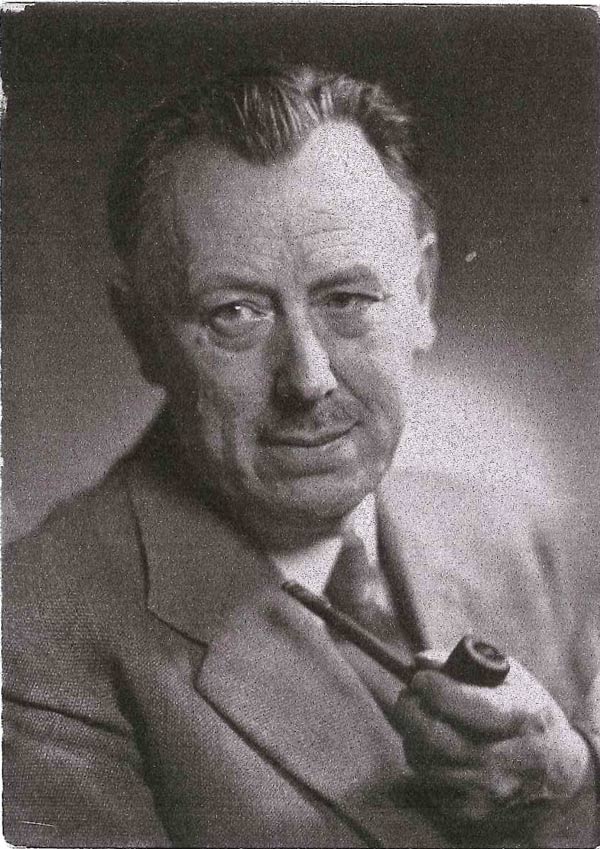Drawings by Speybrouck about the Ascension.
Jozef "Jos" Speybrouck was an early-20th century Flemish graphic artist and illustrator. He was part of the Art Deco movement and notable for his sober and highly stylized linework. The majority of his oeuvre included assignments for Flemish-nationalistic or Catholic organizations. Between 1923 and 1938, Speybrouck published in Flemish comic magazines like Zonneland and made hundreds of biblical-themed text comics. This series, later collected as 'Het Kerkelijk Jaar in Beeld' ("The Church Year in Images", 1931-1932), makes him a pioneer in the field of Belgian Christian comics. He should not be confused with the Bruges children's doctor and politician Jozef Speybrouck (1930-2008).
Early life
Joseph Albert Speybrouck was born in 1891 in Kortrijk (Courtray), West Flanders. His first name was generally shortened to Jozef or Jos. His father Julius Speybrouck (1866-1943) was a painting contractor and restorer of antique furniture, who had his own firm in Kortrijk. The Speybrouck household had eight children, of which Jos and his younger brother Raphaèl Speybrouck (1893-1959) pursued careers in arts, respectively as graphic artist and architect. Other brothers found their calling in religion. Eldest brother Hector Juliaan Speybrouck (1889-1964) worked his way up from assistant pastor to chaplain, while the youngest brother Antoon Speybrouck (1900-1959) was known as a Discalced Carmelite and missionary in India. Religion played an important role in Jos Speybrouck's career as well.
Like many Flemish children of his time, Jozef Speybrouck was raised Catholic. Speybrouck showed an early talent for drawing, so he was signed up at the art academy of Kortrijk, despite being only ten years old at the time. To trick the school principals, Speybrouck's parents used the name of his older brother Hector to sign him in. Between 1905 and 1911, Speybrouck studied and graduated at St. Lucas in Ghent, where he found his vocation as a Catholic and "popular" artist. Among his graphic influences were Ancient Egyptian art, Pre-Raphaelite painters, Art Deco, the Beuron Art School and the work of Walter Crane and Joe English.
Poster advocating Dutch-language universities in Flanders.
Early career
In a woodcut style, Speybrouck illustrated six poems by Flemish poet Albrecht Rodenbach, distributed as postcards during the 1910 World Exhibition in Brussels. He sent several copies to famous Flemish novelists, poets and activists, including Stijn Streuvels, Lodewijk Dosfel, Hugo Verriest, Emiel Lauwers and Cyriel Verschaeve, but none of them replied. Speybrouck's Rodenbach works did catch the interest of the Flemish radicals like doctor Alfons Depla and the educationalist Theodoor Sevens, who had him make vignettes for one of his literary works for school children. Also lin 1910, Speybrouck made an impressionist triptych painting romanticizing Flemish-nationalist heroes, fittingly titled 'De Verheerlijking van Vlaanderen' ("The Glorification of Flanders", 1910) and exhibited at Kortrijk's city hall.
After graduation in 1911, Speybrouck worked as a painter and graphic artist in his father's workshop, eventually setting up his own graphic arts business. During this period, he developed his own graphic style, characterized by its sober, solemn look. Backgrounds are often kept simple so that they don't distract the spectator's eye from the prominently placed people in the foreground. Speybrouck's imagery is accentuated by wavy and dressy linework. Over the course of his career, he would try to capture his characters in as few lines as possible.
During the First World War, Belgium was occupied by German troops. In 1916, they evicted Speybrouck from his Kortrijk home, forcing him to move in with his parents-in-law for a while before spending the rest of the war in Brussels. These events motivated him to make several illustrations with strong anti-militaristic messages. After the Liberation in 1918, Speybrouck and his family moved back to their old home and opened an antique and postcard store. Speybrouck kept the memory of the victims of World War I alive by making a graphic contribution to the collective exhibition 'Haard voor Oorlogsverminkten' (1922), of which the profits benefited handicapped war veterans.
Picture story by Speybrouck about Corpus Christi.
Flemish-nationalistic artwork
During the 1920s and 1930s, the Flemish civil right movement accelerated, with both left-wing and right-wing parties campaigning. In many fields they achieved successes, such as the acceptance of Dutch as the official language at the Ghent University (1930) and new laws establishing the language of the region as its official language (1932). As a fighter for this movement, Speybrouck created much Flemish nationalist propaganda for these purposes. In 1919, he decorated the poster for the festivities commemorating poet Albrecht Rodenbach in his birth town Roeselare. He was a regular contributor to the Flemish nationalist magazine Storm and its sister magazine Gudrun, which aimed at a female demographic. He also designed logos for De Blauwvoet (magazine of the Flemish Catholic student association AKVS, Algemeen Katholiek Vlaams Studentenverbond), De Volksmacht (the official publication of the Christian labor union, department West-Flanders) and the Catholic magazine Hoger Leven.
In 1924, Speybrouck made his most politically conscious assignment, the 'Depla' album. Dr. Alfons Depla was a Flemish surgeon who had collaborated with the German occupiers during World War I. After the war, he fled to the Netherlands, while in his home country he was sentenced to death for treason in absentia. Flemish poet Wies Moens (himself a collaborator during both world wars) wrote a plea against Depla's sentence, for which Speybrouck made the illustrations. Despite their efforts, Depla died one year later from old age, without ever returning to his home country. In 1932, Speybrouck also designed the official poster for the annual "IJzerbedevaart", a pilgrimage traditionally held by Flemish nationalists to commemorate those who have fallen during the First World War and to advocate Flemish self-government.
Catholic artwork
However, the lion's share of Jos Speybrouck's graphic assignments was commissioned by local Catholic priests and organizations. Important clients were the Lannoo printing firm, which released his devotional picture cards, and the abbeys of Affligem, Loppem and Averbode. In the 1920s, he became a regular illustrator for publishing company Averbode. He made drawings for the publisher's Heilige Hart (Holy Heart) calendar and decorated the pages of the magazines Zonneland, Lenteweelde and Averbode's Weekblad. Many of these illustrations were either directly based on the Bible or moralistic works intended to promote Christian values. Throughout his career, Speybrouck designed countless missals, baptism and "in memoriam" cards. In 1924, he illustrated the 'Volksmissaal' and 'Vesperale' booklets of the Benedictine movement of Affligem, based on original texts by Dutch and Flemish poets like Jan van Ruusbroec, Guido Gezelle and Joost van den Vondel. These particular booklets were reprinted for decades on end, making Speybrouck's art more notable outside of his birth province. An oddity in his bibliography are the illustrations he made for Theo Vandebeek's novel 'De Alvermannekes' (Averbode, 1923), a fairy tale about gnomes. In 1934-1935, Speybrouck decorated the church of Waregem with two wall paintings. In 1936, three of his illustrations were included in the Noordstar-Boerhavefonds annual. He received such a good response that next year's issue was completely devoted to his work.
Educational text comic by Jos Speybrouck, depicting David slaying Goliath, 1931-1932.
Comics
Between 1923 and 1938, Speybrouck worked on the longest and most productive assignment of his career. The abbey of Loppem asked him to make illustrations intended for Sunday and Christian holiday masses. These drawings were used during religious ceremonies, at schools and in magazines like Bulletin and La Croisade Liturgique à l'École. He also made maps and didactic illustrations for pupils to cut out. The manual 'Pour Comprendre La Messe' ("To Understand Mass") was a supplementary publication which explained each ritual through the use of text and drawings, once again provided by Speybrouck. This monumental project is easily the artist's magnum opus. Over a period of fifteen years, he made nearly 800 color illustrations that visualized several key moments from the Old and New Testament in text comic format, with the narrative in captions beneath each image. These comics were later published in book form by Gaspard Lefebvre, abbot of Loppegem, in French as 'Le Cycle Liturgie en Images' and in Dutch as 'Het Kerkelijk Jaar in Beeld' (1931-1932). Catholic educators considered them so useful that they distributed them all over Flanders, also translating them over the Belgian borders. Despite the success, Speybrouck felt working on the same topic for more than a decade was tiring, while Catholic censors left him with little creative freedom.
Speybrouck made several other religious picture stories, such as the 'Missiereeks' ("Mission series", 1925) for the Redemptorist movement. These six illustrations symbolized and glorified the actions of Catholic missionaries abroad. 'Via Crucis' (1928) was a text comic adaptation of Jesus' Calvary, while 'De Zeven Weeën van Maria' (1928), depicted the Virgin Mary's labor pains. '15 Heilige Geheimenissen' (1929) visualized glorious Christian mysteries and their emotional impact through one and the same character. 'Sterrenbeelden' (1929) was a graphic interpretation of all animals and symbols of the Zodiac. 'Levensgang' (1929) had a more philosophical tone, illustrating the heights and lows of one person's life until the inevitability of death, while 'De Zeven Werken van Barmhartigheid' (1929) depicted the Seven Virtues. In 1932, the artist also illustrated biblical history in the book 'Bijbelse Geschiedenis' by Dr. J. Keulers.
One of Speybrouck's most beautiful projects was 'Levenslijnen' ('Lifelines', 1928), in which he brought his graphic style to its most minimal essence. The illustrations depict an angelic woman praying to God. She is stylized into a horizontal, almost rectangular character. The background consists of only a huge circle, while the drawings themselves are an interesting display of circles, rectangles and triangles put in a geometrical balance. 'Levenslijnen' is the closest Speybrouck ever came to making a comic strip with speech balloons, seeing that the monologues are written within the images rather than underneath them.
Teaching career
In addition to his work as graphic artist, Jozef Speybrouck was also active as an educator. He desired to become a teacher at the Academy of Kortrijk, but was never admitted because of his Flemish nationalist activism. In 1923, the artist did receive a position as art teacher at the O.L. Vrouw-Bijstand Institute in Kortrijk, which had just changed its entire curriculum from French to Dutch. Four years later, he received the same job at the École Polytechnique in Mons, Belgium and in 1930 at the St. Lucas School of Doornik (Tournai). Speybrouck also made his teaching methods available to the general public. He published a book about drawing human anatomy named 'Proporties - Ontleedkunde en Uitdrukking' (1935). Later in life, he was preoccupied with the organization of various processions, such as the Eucharistic Congress of Kortrijk (1930), the Vredesstoet in Roeselare (1945), the Guldensporen festivities in Kortrijk (1952) and the St. Godelieve procession in Gistel (1952), for which he designed posters, stage sets and costumes. Between 1940 and 1941, Speybrouck was briefly creative advisor of the Kortrijk city council and its architectural commission, but quit after only a year because he didn't like the political gameplay.
Final years and death
In 1956, Speybrouck underwent an operation. He passed away one day before he was allowed to return home, in his birth town Kortrijk. He was 65 years old. While Jozef Speybrouck isn't as well known today as some of his contemporaries, he still holds historical significance as one of the pioneers in Christian comics. In fact, when Jozef Peeters published a small book about this particular comics genre in Flanders, 'De Christelijke Strip in Vlaanderen' (Lobergen, 2011), Speybrouck was not only included in this retrospective, one of his works actually graced the book cover.


